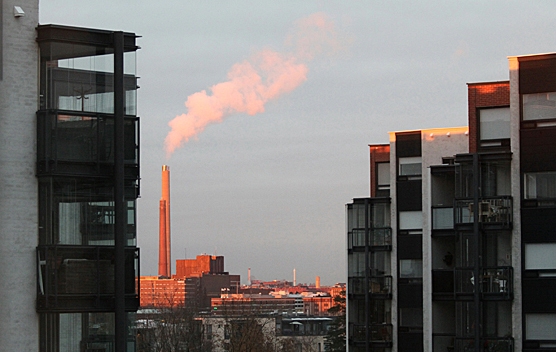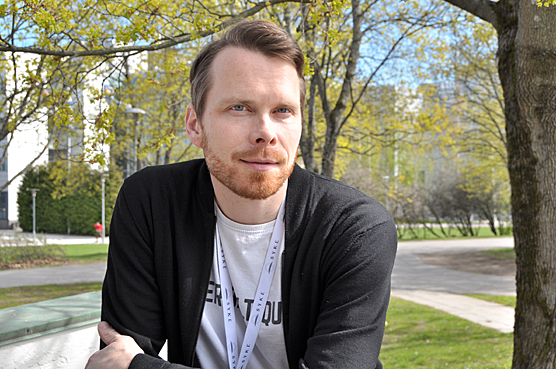
© Olli-Pekka Pietiläinen
The goal of the Finnish Environment Institute (SYKE) is to calculate the amount of climate emissions of all Finnish municipalities as well as their development during the past 15 years. Emission calculation provides a starting point for the municipalities’ climate work.
“Emission calculation is a key climate policy tool. It is very important that we have a reliable, transparent and mutually agreed model for monitoring the development of emissions. Of course, we know where emissions are created and how to reduce them on a general level, but clear indicators are needed to support credible policy,” says Senior Specialist Johannes Lounasheimo, who leads the emission calculation project at SYKE.
The first phase of the emission calculation of municipalities focuses on the years 2005–2017, because 2005 is the reference year for the emission reduction target of the EU. As far as possible, emissions are also determined for the year 1990, which has been commonly used as a reference year since the Kyoto Protocol was enacted. In the future, the data will be updated annually at least for the duration of the Canemure project, i.e. until 2024.
“The monitoring allows us to see whether climate policy measures have had an impact or not. In addition, climate measures can be targeted and prioritised correctly when we know the source and magnitude of the emissions,” Lounasheimo says.
Based on previous calculations on municipalities in the Carbon Neutral Municipalities network (Hinku), the emissions have decreased by 27 per cent on average since 2007. The greatest reductions have been achieved in Hanko and Rauma, mainly due to a decrease in industrial emissions. Emission reductions are also significant in the small municipality of Ii, where considerable emission compensations can be calculated for the municipality thanks to the production of wind power.
Tackling the challenges of emission calculation
Climate emissions come from several different sources, and their systematic and comparable calculation at the municipal level is a major challenge. The work has nevertheless already been done in Finland for years using the Kasvener model. The key factor in the ongoing development project is to improve the coverage of emission sources and the quality of initial data and to update the sector-specific calculation models.
One area in need of development involves the emissions caused by work machines. They are not calculated based on municipality-specific initial data; instead, the overall emissions of Finnish work machines are divided between the municipalities based on certain grounds. In growth municipalities with a lot of construction as well as municipalities with plenty of agriculture and forestry, emissions from work machines may play a large role.
Another difficult sector for the availability and quality of initial data is property-specific heating. “Information on the changes in the heating methods of buildings is not necessarily transferred into the statistics quickly enough, or at all. During the year, we will also attempt to develop as good a model as possible for estimating emissions in this regard, too,” Lounasheimo says.
“As for road traffic, we are looking into the possibility of calculating the emissions based on the kilometres driven in the municipality and by its residents instead of the current area-based calculations. The through traffic on major roads that the municipality cannot influence in any significant way has a major impact on the emissions of many small municipalities. Municipalities have wished that the calculations could be developed so that only the municipality’s own traffic emissions would be included,” Lounasheimo says. “In addition, water and rail traffic will be added to the monitoring.”

Johannes Lounasheimo © Hannele Ahponen, SYKE
The calculation model of SYKE complies with the international standard
The most important goal in developing emission calculations is to produce comparable data for municipalities and regions within Finnish territory. However, it is also ensured that the emission calculations comply with the GPC standard of the international Greenhouse Gas Protocol, which makes them internationally comparable.
The starting point of the current emission calculations by SYKE, which are based on consumption, consists of the production-based emissions in the area, created geographically within the municipal borders. However, the emissions from electricity, heat and waste processing are calculated based on consumption. The method corresponds to the BASIC level of the GPC with the addition of agriculture. In the future, the plan is to include a new traffic calculation model, F-gases, as well as the emissions from land use and forestry sectors into the emission inventories on the municipal level. In that case, the emissions of Finnish municipalities would be reported according to the BASIC+ level.
“In order to guarantee effective climate work by municipalities, it is essential that the results of the emission calculations are used. For this purpose, SYKE will draw up an illustrative, online-based emissions reporting service for all municipalities during 2020. In the service, you can compare municipalities, regions or larger areas, or you can study the emission sources and the development of emissions in your own municipality from different points of view,” Lounasheimo says.
As a legacy of the calculations made for the Carbon Neutral Municipalities (Hinku), the updated model will also give municipalities emission compensations for wind power produced in the area, and in the future, other compensation mechanisms may also be added. The emission results are presented so that based on the selection, the effect of the compensations is either shown or not shown in the results.
The emissions and electricity consumption of facilities within the scope of the emissions trading system of the EU have not been included in the emissions of the Carbon Neutral Municipalities (Hinku), excluding the fuel consumed in the production of district heat. The aim is to offer the users of the future reporting service an option of including emissions trading as a whole.
Emissions based on consumption will also be included in the future
The currently used emission calculation models do not take account of all consumption-based emissions created by the activities of municipalities and their residents. Among other things, they include public and private purchases, such as food, construction materials and travel. In fact, the aim is to introduce emission calculation based completely on the consumption of municipalities and regions in addition to the usual annual monitoring of emissions.
“The climate impact of emissions based on consumption is significant, especially in areas such as the Helsinki Metropolitan Area with relatively little industry. For the climate, it is necessary to carry out measures with an effect that is not directly visible in the traditional emission calculations,” Lounasheimo notes.
More information:
Senior Specialist Johannes Lounasheimo, SYKE
firstname.lastname@ymparisto.fi
The ALas project for the development of regional greenhouse gas calculations was started with funding from the municipal climate change solutions programme of the Ministry of the Environment; it improves the knowledge base of the calculations and their comprehensiveness and transparency, as well as the quality, reporting and updatability of the results.